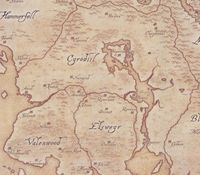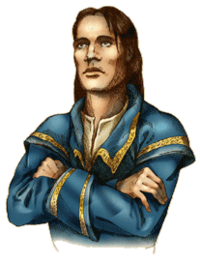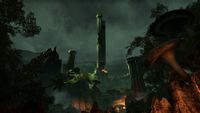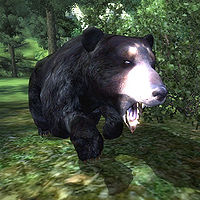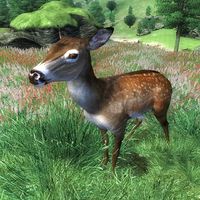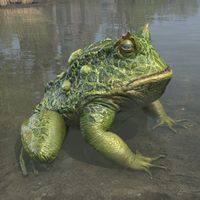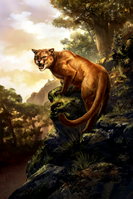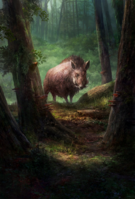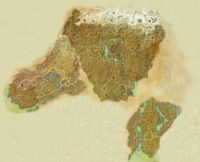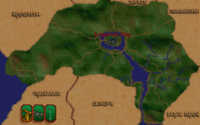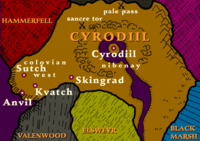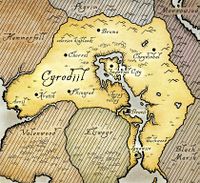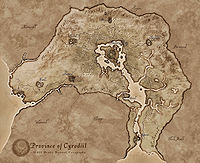Lore:Cyrodiil
| This page is currently being redesigned for the Lore Places Project (LPP). The page may need work to meet the standards outlined on the project page. |
| Cyrodiil | |
|---|---|
| Type | Province |
| Continent | Tamriel |
| Demonym(s) | Cyrodil, Cyrodilic, Cyrod |
| Appears in | Arena, Oblivion, Oblivion Mobile, The Infernal City, Lord of Souls, ESO, Legends, Blades, Castles |
Cyrodiil, also known as the Imperial Province, Dragon Empire, Starry Heart of Nirn, and Seat of Sundered Kings,[1][2] and Cyrod in Ayleidoon,[3][4] is a province in south-central Tamriel that is home to the human race known as Imperials. The center of their empire and seat of governance, Cyrodiil is also known as "the Heartland". The capital of both Cyrodiil and the empire, the Imperial City, is located on City Isle in the center of the province; at the heart of the city is White-Gold Tower, possibly the most renowned monument in Tamriel. Despite some accounts describing Cyrodiil as a jungle,[5] it has a primarily temperate climate.[6][7] One scholar of the middle Second Era attributed this discrepancy to errors made during the transcription of historical texts,[8] while another speculated that White-Gold Tower itself adapted the climate to suit the region's inhabitants.[9] Later sources asserted that Emperor Tiber Septim altered Cyrodiil's climate after he united all the provinces under his rule.[UOL 1][10]
History[edit]
When the Aldmeri landed in the Summerset Isles, they did not move far inland, but told of ancient beasts before men or mer. Unfortunately, oral tradition only gives unclear glimpses of what they may have looked like. One account describes the ancient inhabitants of City Isle as a race of Bird Men.[11] The only definite information of Cyrodiil's history is after the beginning of recorded history when the Ayleids came to call Cyrodiil their home. Described in A Pocket Guide to the Empire, "The Ayleids were ancient Aldmer, cousins of all the elven races that exist to this day. Over time, they became a distinct people, crafting a civilization whose ruins still puzzle and fascinate modern archaeologists and adventurers." The Nedic people of the region became slave labor for the Ayleids once man-mer tensions in Skyrim reached a boiling point. One of the most important events of Cyrodilic history is the slave rebellion of 1E 242. The men and mer had been fighting in Skyrim for quite a while. This revolt was led by Alessia, who handed the entire region to the insurgent humans. "The heart of Tamriel was going to belong to these former slaves, present day Cyrodilics or Imperials, forever more."[2]
In an alliance with Skyrim, the Alessian Empire pushed to the west towards High Rock which at the time was under the control of the Direnni. Another big change was present at this time: as described in A Pocket Guide to the Empire, "The prophet Marukh's teachings brought both identity to Cyrodiil, codifying the pantheon most civilized Tamriellians worship to this day." It also caused conflict due to the more severe strictures he espoused.[2] The next large event in the history of Cyrodiil occurred in the year 1E 2703: the Akaviri invasion. This event not only affected Cyrodiil, but it brought all of Tamriel together to fight the new threat. The Akaviri were driven off, and the people of Tamriel subsequently became more cooperative with one another. Under the rule of Emperor Reman I, Cyrodiil became cosmopolitan and incorporated aspects of High Rock, Colovian, Nibenese, and even Akaviri culture. The Second Empire of Cyrodiil continued to expand, engulfing almost all of Tamriel. All was normal until the assassination of Emperor Reman III and his son Juilek. The assassinations marked the end of the First Era and the Second Empire. The government was under the control of Akaviri Potentates, and it continued to evolve until the last Potentate was killed in 2E 430. Throughout the rest of the Second Era, Tamriel was in the time known as the Interregnum. Nibenay and Colovia split apart; farms, villages, and even highways were in ruin. Many tried to claim the Imperial throne and this chaos lasted for centuries. The only hope for Tamriel was Tiber Septim. He started the Third Empire by unifying Cyrodiil and then the rest of Tamriel during the Tiber War. The Empire has thrived since then but was weakened by the War of the Red Diamond and The Imperial Simulacrum.
At the end of the Third Era, Tamriel was left with no emperor. In the early Fourth Era, the Empire nearly collapsed and Cyrodiil's counties of Leyawiin and Bravil seceded until circa 4E 22, when Titus Mede led an army to conquer the Imperial City and was crowned the first emperor of the Mede Dynasty. Cyrodiil was again reunited but would face a new era of bloodshed against the Aldmeri Dominion starting in 4E 171, triggering the Great War after the Thalmor's ultimatum was rejected by Titus Mede II. Cyrodiil was invaded by the Thalmor, who took the Imperial City by force and committed many atrocities on the helpless population. It wasn't until 4E 175 that the Imperial Legion was able to retake the Imperial City during the Battle of the Red Ring, resulting in the destruction of all Aldmeri forces in Cyrodiil. Although the Imperials emerged victorious, they felt they were unable to continue the war and ended the Great War with the signing of the White-Gold Concordat, banning the worship of Talos and ceding a large portion of southern Hammerfell to the Dominion, leading to Skyrim's distrust.
Home of the Red King Once Jungled[edit]
Cyrodiil, despite its typically temperate climate,[6][7] has mysteriously been jungled or at least described as jungled at several points in its history. The Serpent was a being who wished to return Tamriel to its primordial state, in a vision created by it depicting a future in which it succeeded, the Imperial City was overgrown by a jungle.[12] In the early First Era, during the reign of the Ayleid Empire, contemporary sources (such as the Hosiric Lays and the Tamrilean Tractates) described Cyrodiil as having jungle foliage.[9][13][14] King Edward, a historical fiction set in a later part of the First Era, described Cyrodiil as temperate.[15] As of 2E 582 Cyrodiil was well known to temperate.[6] Scholars of the time debated the nature of Cyrodiil's supposed jungles. In his book The Heartland of Cyrodiil, Phrastus of Elinhir held the opinion that Cyrodiil ever having been jungled was a matter of transcription errors.[8] However, his intellectual rival Lady Cinnabar of Taneth, had a more involved theory in her book, Subtropical Cyrodiil: A Speculation. She posited the idea that the White-Gold Tower, which possesses incredible metaphysical power, is capable of changing the climate of Cyrodiil to suit the current civilization in power. As the Ayleids were from the tropical Summerset Isles, she believes Cyrodiil was changed when they were in power to reflect their tastes, with Men coming into power causing a cooler shift in climate.[9]
A large tropical forest known as the Dawnwood would be grown near Skingrad by the Recollection, a cult of Bosmer who believed the Ayleids were their ancestors and sought to reclaim their ancient lands.[16] Their plans were stopped before they could expand the Dawnwood to more of Cyrodiil.[17] However, by 2E 864, Cyrodiil was recorded as being fully jungled. The first edition of the Pocket Guide to the Empire described the province at this time as mostly endless jungle.[1] Certain writings claim that at the onset of his fully unified reign, Tiber Septim acknowledged that the dense jungles that encompassed Cyrodiil were hated by his people, thus he proclaimed to have breathed in royalty to reshape the very land that his Red Legions dwelt upon, supposedly ridding it of the endless jungle.[10][18][UOL 1] After that Cyrodiil was known to have remained temperate,[7] though books describing Cyrodiil as mostly jungled were still being published into the late Third Era,[5] with some on Vvardenfell strangely describing the province to be jungled circa 3E 427.[19]
Geography[edit]
Cyrodiil has a varied environment, and is divided into several regions:
- Nibenay Basin: This vast region dominates Cyrodiil, containing all the area that drains into the River Niben. The area around the Imperial City and the Upper Niben is often known as "the Heartlands". East of the river, the region consists of mostly open fields while to the west and north it is more wooded. The Imperial City covers City Isle in the center of Lake Rumare, the source of the Niben, and the city of Bravil is located on the banks of Niben Bay in the "Nibenay Valley".
- Great Forest: An immense woodland area just west of the Imperial City.
- Colovian Highlands: A hilly, forested region of western Cyrodiil with the town of Chorrol as its main settlement.
- West Weald: The open countryside of southern Cyrodiil that is well known for its vineyards. The city of Skingrad is located here.
- Gold Coast: The western coastline of Cyrodiil that is dotted by farms. The main settlements of the region are the port city of Anvil, and the city of Kvatch further inland.
- Jerall Mountains: A mountain range in northern Cyrodiil on the Skyrim border, containing the town of Bruma.
- Valus Mountains: A mountain range in eastern Cyrodiil on the Morrowind border. The city of Cheydinhal is located at the foothills.
- Blackwood: A swampland in southern Cyrodiil east of Leyawiin, along the Black Marsh border.
Architecture[edit]
Ayleid[edit]
The Ayleid forebears of Cyrodiil lived in numerous competing city-states throughout the province, with settlers expanding into regions like Black Marsh, Valenwood, and Hammerfell. Alyied architecture is most recognizable by its use of white-marble. Most Ayleid ruins extend deep underground and are filled with deadly traps. They are also designed to channel starlight into magic with several chambers containing welkynd stones.
While there are several settlements built upon Ayleid sites like Bravil, the most well preserved Ayleid Architecture is the Imperial City and the White Gold Tower, the heart of several Cyrodiilic Empires.
Imperial[edit]
Cyrodiil has been home to four incarnations of 'the Empire', starting from the Allessians in the First Era. Imperial forts have been built across Tamriel, and Imperial roads connect the continent together. The Imperials are also known for their construction of villas by the wealthy.
Emperor's Hestra and Reman also placed numerous wayshrines believed to coincide with expansions of the road network.
Nordic[edit]
With the Alessian Slave Rebellion the Nords were granted territory within the Nibenay Valley. Their strongest influence is seen in the city of Bruma, which lies close to the border in the Jerrall mountains.
Dark Elf[edit]
With their integration into the Third Empire, a large population of Dark Elves settled in Cyrodiil, particularly in Cheydinhal County, where they brought with them a unique fusion of architectural techniques, referred as 'half-timbering'. This style is unique in both Cyrodiil and their home province of Morrowind, which is known for much more esoteric styles. Half-timbering architecture incorporates stone bases, with exposed wood beams and white plaster with concave rooves, with intricate designs being used.
Fauna[edit]
Cyrodiil is home to many carnivorous creatures such as bears, wolves, and mountain lions, which all often prey upon deer. Giant bugs such as hoarvors and shalks are uncommonly seen, but they are known to live deep underground in Cyrodiil.[20]
Notable Places[edit]
- Anvil
- A harbor city on the Gold Coast.
- Bloodfall
- A petty kingdom founded within the borders of Cyrodiil during the Fourth Era. The town of Rivercrest falls directly under its domain.
- Bravil
- A rundown, squalid town on the west bank of the Niben.
- Bruma
- A town in the northern Jeralls boasting Nordic population and character.
- Caer Suvio
- A settlement famous for its hot springs.
- Cheydinhal
- A town in eastern Cyrodiil with a large Dunmer population.
- Chorrol
- A town located between the Great Forest and Colovian Highlands, in the northwestern region of Cyrodiil.
- Cloud Ruler Temple
- An ancient fortress of Akaviri origin. It served as a fortress for the Emperor's bodyguards, the Blades, before they were disbanded.
- Imperial City
- The capital of Cyrodiil and the whole of the Empire. It is located on City Isle in central Lake Rumare.
- Kvatch
- A city on the Gold Coast between Anvil and Skingrad, built on a large plateau. It is north of the River Strid in Colovia.
- Leyawiin
- A city at the southern reaches of Cyrodiil, straddling the Niben River where it meets Topal Bay.
- Sancre Tor
- Now little more than a ruined fortress, the city and location of Sancre Tor has been the site of important events since the First Era.
- Skingrad
- A large town located in the West Weald region to the southwest of the Imperial City, along the Gold Road.
- Sutch
- An abandoned settlement located in the Gold Coast region.
Gallery[edit]
Notes[edit]
- Prior to The Elder Scrolls Adventures: Redguard, Cyrodiil was known as the "Imperial Province".
- The King Edward books refer to Cyrodiil as either the Wilderland[15] or the Wilderness.[21] The character Moraelyn describes it as a "wide green land of rolling hills with only a few stands of trees. It seemed to spread on forever." He later claims in the next line, "Be on your guard. It seems a pleasant land, but no king's writ runs here. Each man's hand is against every other's -- and there are worse than men. All the races of Tamriel meet here, and clash, save thine, perhaps."
See Also[edit]
- For game-specific information, see the Arena, Oblivion, and Elder Scrolls Online articles.
Books[edit]
- The Heartland of Cyrodiil by Phrastus of Elinhir — A description of the Heartlands
- Subtropical Cyrodiil: A Speculation by Lady Cinnabar of Taneth — Thoughts on the climate of Cyrodiil and its relationship to the White-Gold Tower
References[edit]
- ^ a b Pocket Guide to the Empire, 1st Edition: Cyrodiil — Imperial Geographical Society, 2E 864
- ^ a b c Pocket Guide to the Empire, 3rd Edition: The Seat of Sundered Kings: Cyrodiil — Imperial Geographical Society, 3E 432
- ^ Mock Q&A for The Origin of Cyrus!
- ^ The Song of Pelinal, v 3
- ^ a b Provinces of Tamriel
- ^ a b c Appearance of Cyrodiil in ESO
- ^ a b c Appearance of Cyrodiil in Oblivion
- ^ a b The Heartland of Cyrodiil — Phrastus of Elinhir
- ^ a b c Subtropical Cyrodiil: A Speculation — Lady Cinnabar of Taneth
- ^ a b Mythic Dawn Commentaries 3 — Mankar Camoran
- ^ Father of the Niben — Florin Jaliil
- ^ Events of The Oldest Ghost in ESO
- ^ Before the Ages of Man — Aicantar of Shimerene
- ^ The Song of Pelinal, v 2
- ^ a b King Edward, Part VIII — Anonymous
- ^ Beragon's dialogue in ESO: Gold Road
- ^ Events of ESO: Gold Road
- ^ Heimskr's dialogue in Skyrim
- ^ Generic Dialogue in Morrowind
- ^ Tribune Alea Idolus' dialogue in ESO
- ^ King Edward, Part X — Anonymous
Note: The following references are considered to be unofficial sources. They are included to round off this article and may not be authoritative or conclusive.
- ^ a b From The Many-Headed Talos, Michael Kirkbride
| ||||||||||||||||||||
